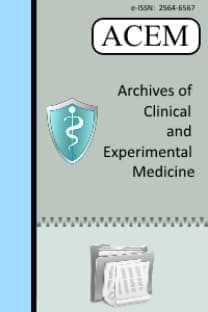Tüm apendektomi örneklerinin histopatolojik olarak değerlendirilmesi gerekli midir?
Akut apandisit, apendektomi, apendektomi materyali, histopatolojik değerlendirme, histopatolojik tanı, beklenmeyen bulgular
Should histopathological evaluation of all appendectomy specimens essential?
Acute appendicitis, appendectomy, appendectomy specimen, histopathologic evaluation, histopathologic diagnose, unexpected findings,
___
- 1. Unver N, Coban G, Arici DS, Buyukpinarbasili N, Gucin Z, Malya FU, et al. Unusual Histopathological Findings in Appendectomy Specimens: A Retrospective Analysis of 2047 Cases. International Journal of Surgical Pathology. 2018: 1-5.
- 2. Duzgun AP, Moran M, Uzun S, Ozmen MM, Ozer VM, Seckin S, et al. Unusual findings in appendectomy specimens: Evaluation of 2458 cases and review of the literatüre. Indian Journal of Surgery. 2004; 66 (4): 221-26.
- 3. Elfaedy O, Benkhadoura M, Elshaikhy A, Elgazwi K. Impact of routine histopathological examination of appendectomy specimens on patient management: a study of 4012 appendectomy specimens. Turk J Surg 2019; 35 (3): 196-201.
- 4. Malhotra K, Bawa A. Routine Histopathological Evaluation After Appendectomy: Is It Necessary? A Systematic Review. Cureus 12(8): e9830.
- 5. Yilmaz M, Akbulut S, Kutluturk K, Sahin N, Arabaci E, Ara C, et al. Unusual histopathological findings in appendectomy specimens from patients with suspected acute appendicitis. orld J Gastroenterol 2013; 19(25): 4015-4022.
- 6. Jones AE, Phillips AW, Jarvis JR, Sargen K. The value of routine histopathological examination of appendicectomy specimens. BMC Surgery 2007; 7: 17.
- 7. Khan OA, Morhan A, Jegatheeswaran S, Jackson E, Pellikan A, et al. Routine Pathological Analysis of Appendicectomy Specimens — Is it Justified? Acta Chirurgica Belgica 2007; 107(5): 529-530.
- 8. Akbulut S, Tas M, Sogutcu N, Arikanoglu Z, Basbug M, Utku A, et al. Unusual histopathological findings in appendectomy specimens: A retrospective analysis and literature review. World J Gastroenterol 2011; 17(15): 1961-1970.
- 9. Matthyssens LE, Ziol M, Barrat C, Champault GG. Routine surgical pathology in general surgery. British Journal of Surgery 2006; 93: 362–368.
- 10. Gorter RR, van Amstel P, van der Lee JH, van der Vorn P, Bakx R, Heij HA. Unexpected findings after surgery for suspected appendicitis rarely change treatment in pediatric patients; Results from a cohort study. Journal of Pediatric Surgery 2017: 1269–1272.
- 11. Ma KW, Chia NH, Yeung HW, Cheung MT. If not appendicitis, then what else can it be? A retrospective review of 1492 appendectomies. Hong Kong Med J 2010; 16: 12-7.
- ISSN: 2564-6567
- Yayın Aralığı: Yılda 3 Sayı
- Başlangıç: 2016
- Yayıncı: -
Tüm apendektomi örneklerinin histopatolojik olarak değerlendirilmesi gerekli midir?
Mustafa Ömer YAZICIOĞLU, Mustafa DÖNMEZ
Nuray CAN USTA, Vildan ALTUNAYOĞLU ÇAKMAK, İsmet DURMUS, Murat TOPBAŞ, Zeynep KAZAZ, Oguzhan Ekrem TURAN
Bir COVID-19 hastasında sialadenit ve tiroiditin atipik birlikteliği: Bir olgu sunumu
Deniz İNCAMAN, Gamze Gül GÜLEÇ
Abdullah ŞENLİKCİ, Koray KOŞMAZ, Abdullah DURHAN, Marlen SÜLEYMAN, Yusuf Murat BAG, Mevlüt Recep PEKCİCİ, Mehmet ŞENEŞ, İlknur ALKAN KUŞABBİ, Ozlem TANAS ISIKCI, Yılmaz ÜNAL, Sema HÜCÜMENOĞLU
Nesrin GÜNDÜZ, Başak ATALAY, Umut Perçem Orhan SÖYLEMEZ
Türk popülasyonunda primer glenohumeral osteoartrit sınıflaması – morfolojik çalışma
Gökay EKEN, Turan Bilge KIZKAPAN, Mustafa ÖZÇAMDALLI, Erdal UZUN, Sinan OĞUZKAYA
Refraktif akomodatif ezotropya hastalarında stereopsis düzeyi ve ilişkili faktörler
Semptomatik hepatik hemanjiomlarda cerrahi tedavi deneyimi
Oğuzhan ÖZSAY, Mehmet Can AYDIN
Mevlüt Recep PEKCİCİ, Marlen SÜLEYMAN, Koray KOŞMAZ, Mehmet ŞENES, Özlem TANAS IŞIKÇI, Abdullah ŞENLİKÇİ, İknur ALKAN KUSABBİ, Yılmaz ÜNAL, Yusuf Murat BAĞ, Sema HÜCÜMENOĞLU
